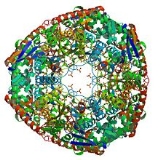
Polynucleotide phosphorylase
Encyclopedia
Polynucleotide Phosphorylase (PNPase) is a bifunctional enzyme
with a phosphorolytic
3' to 5' exoribonuclease
activity and a 3'-terminal oligonucleotide
polymerase
activity. It is involved on mRNA processing and degradation in bacteria, plants, and in humans.
In humans, the enzyme is encoded by the gene. In its active form, the protein forms a ring structure consisting of three PNPase molecules. Each PNPase molecule consists of two RNase PH
domains, an S1 RNA binding domain and an K-homology domain
. The protein is present in bacteria
and in the chloroplasts and mitochondria of some eukaryotic cells. In eukaryote
s and archaea
, a structurally and evolutionary related complex exists, called the exosome
.
The same abbreviation (PNPase) is also used for another, otherwise unrelated enzyme, Purine nucleoside phosphorylase
.
Enzyme
Enzymes are proteins that catalyze chemical reactions. In enzymatic reactions, the molecules at the beginning of the process, called substrates, are converted into different molecules, called products. Almost all chemical reactions in a biological cell need enzymes in order to occur at rates...
with a phosphorolytic
Phosphorolysis
Phosphorolysis is the cleavage of a compound in which inorganic phosphate is the attacking group. It is analogous to hydrolysis.An example of this is glycogen breakdown by glycogen phosphorylase, which catalyzes attack by inorganic phosphate on the terminal glycosyl residue at the nonreducing end...
3' to 5' exoribonuclease
Exoribonuclease
An exoribonuclease is an exonuclease ribonuclease, which are enzymes that degrade RNA by removing terminal nucleotides from either the 5' end or the 3' end of the RNA molecule...
activity and a 3'-terminal oligonucleotide
Oligonucleotide
An oligonucleotide is a short nucleic acid polymer, typically with fifty or fewer bases. Although they can be formed by bond cleavage of longer segments, they are now more commonly synthesized, in a sequence-specific manner, from individual nucleoside phosphoramidites...
polymerase
Polymerase
A polymerase is an enzyme whose central function is associated with polymers of nucleic acids such as RNA and DNA.The primary function of a polymerase is the polymerization of new DNA or RNA against an existing DNA or RNA template in the processes of replication and transcription...
activity. It is involved on mRNA processing and degradation in bacteria, plants, and in humans.
In humans, the enzyme is encoded by the gene. In its active form, the protein forms a ring structure consisting of three PNPase molecules. Each PNPase molecule consists of two RNase PH
RNase PH
RNase PH is an 3'-5' exoribonuclease and nucleotidyltransferase, present in archaea and bacteria, that is involved in tRNA processing. Contrary to hydrolytic enzymes, it is a phosphorolytic enzyme, meaning that it uses inorganic phosphate as a cofactor to cleave nucleotide-nucleotide bonds,...
domains, an S1 RNA binding domain and an K-homology domain
Protein K
Protein K may refer to:* Protein K , a porin expressed in pathogenic strains of E. coli* Protein K , a DNA- and RNA-binding protein expressed in the nucleus of eukaryotes...
. The protein is present in bacteria
Bacteria
Bacteria are a large domain of prokaryotic microorganisms. Typically a few micrometres in length, bacteria have a wide range of shapes, ranging from spheres to rods and spirals...
and in the chloroplasts and mitochondria of some eukaryotic cells. In eukaryote
Eukaryote
A eukaryote is an organism whose cells contain complex structures enclosed within membranes. Eukaryotes may more formally be referred to as the taxon Eukarya or Eukaryota. The defining membrane-bound structure that sets eukaryotic cells apart from prokaryotic cells is the nucleus, or nuclear...
s and archaea
Archaea
The Archaea are a group of single-celled microorganisms. A single individual or species from this domain is called an archaeon...
, a structurally and evolutionary related complex exists, called the exosome
Exosome complex
The exosome complex is a multi-protein complex capable of degrading various types of RNA molecules...
.
The same abbreviation (PNPase) is also used for another, otherwise unrelated enzyme, Purine nucleoside phosphorylase
Purine nucleoside phosphorylase
Purine nucleoside phosphorylase also known as PNPase and inosine phosphorylase is an enzyme that in humans is encoded by the NP gene.- Function :Purine nucleoside phosphorylase is an enzyme involved in purine metabolism...
.

